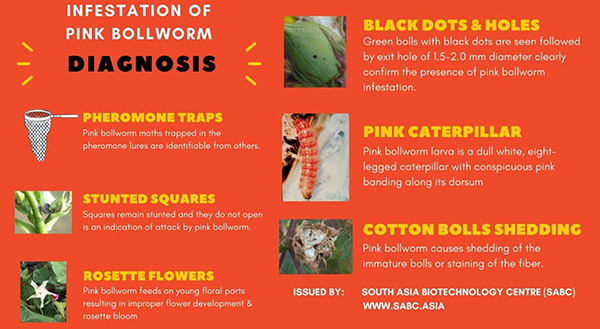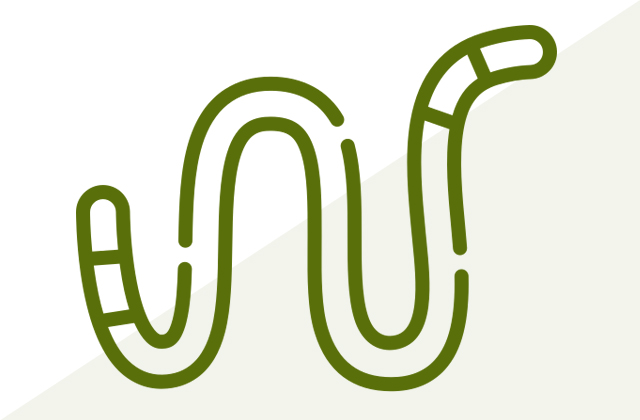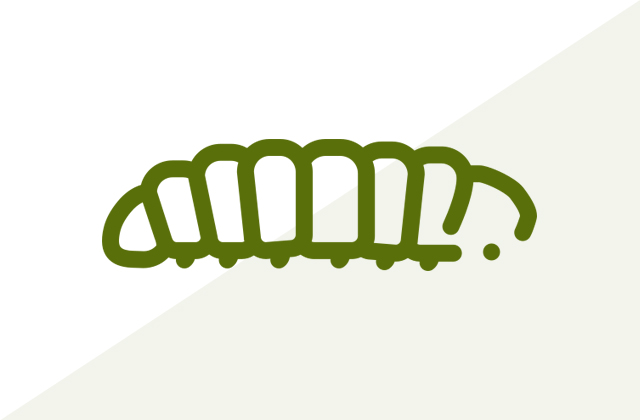Pink Bollworm Aka Pbw
Cotton Pest Dynamics
Cotton is known to harbour several pests. However, early stage attack of sucking pests, middle stage attack of early shoot borer, American bollworm and late stage damage of pink bollworm are of serious concern in successful cultivation of cotton particularly in rainfed situations of Maharashtra and other States and hence cotton farmers resort to continuous insecticidal sprays.
Figure 1. Cotton pest dynamics in India

Source: Analysed by South Asia Biotechnology Centre, 2021
Management of sucking pest using IPM system has been fairly successful, but the bollworms viz., spotted (Erias vittela, E. insulata), American (Helicoverpa armigera), cutworm (Spodoptera litura) and the pink bollworm (Pectinophera gossypiella) often defy the traditional management strategies and cause epizootic conditions restricting the cotton production. In fact, the major reason of introducing the Bt Cotton in India in 2002 was frequent outbreaks of American bollworm and subsequent heavy use of insecticides. Indian cotton yield were stagnant from 1985 till 2002 at or below 300 kg lint per ha in spite of an average 12-14 sprays of all kinds of insecticides.
After the introduction of Bt Cotton in 2002, there was an excellent response to curtail the incidence of all bollworms because the Bt gene provided inbuilt protection against them. Initially, CryIAc was introduced but when it was observed that the single gene may develop resistance in the bollworm pests, in 2006 the double gene CryIAc + Cry2Ab, were permitted as Bollgard®II technology. Over the year the Bollgard®II Bt cotton cultivars were adopted by farmers. The adoption rate of Bt cotton was mindboggling as nearly 95% of the total cultivable area under cotton is occupied by Bt cotton since 2020. To add to this situation, commercially more than 1400 Bt cotton hybrids of all sorts of registered seed companies were permitted. As a result of widespread cultivation of high yielding Bt cotton hybrids, the cotton production was transformed and India became a net exporter of cotton in 2006. The cotton yield peaked at 566 kg lint ha in 2013-14 and subsequently tapered around 500 kg lint per ha until 2020. However, cotton production surged to 36 million bales in 2019-20 from 13.6 million bales in 2002-03.
Figure 2. Cotton area, production and adoption of Bt cotton technology, 1950-2020
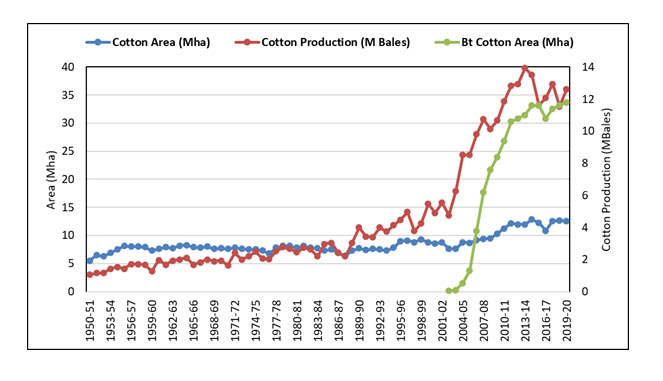
Source: MOA&FW, 2021; Analysed by South Asia Biotechnology Centre, 2021
The Pink Bollworm: The Dreaded Pest
Pink bollworm, Pectinophora gossypiella is one of the major pests of American bollworm complex. It is known to occur during later stages of cotton crop growth. Till 1980, pink bollworm used to cause havoc in various cotton growing areas of India. While Helicoverpa infestation results in definite yield loss, pink bollworm infestation primarily affects the lint quality, though early occurrence may lead to reduction in yield.
The pest dynamism of pink bollworm changed significantly over the period of time during the large scale adoption of Bt cotton technology. The basic condition of refugia planting in Bt cotton adoption was totally violated as farmers did not want to lose some land for susceptible cotton around Bt fields as refugia. This culminated into erosion of resistance to pink bollworm and slowly build up the pest population in the cotton fields. Till 2014 there was sporadic occurrences of PBW in Maharashtra and Andhra Pradesh but an unusual survival of PBW larvae on flowers at 60-70 days after sowing was detected in Gujarat followed by measurable damage to Bt cotton hybrids during November 2014 in Gujarat.
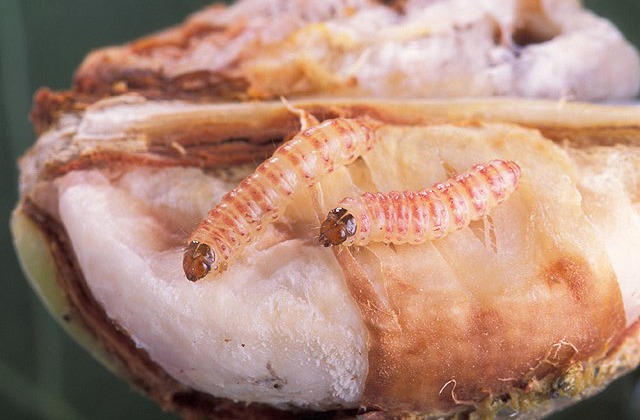
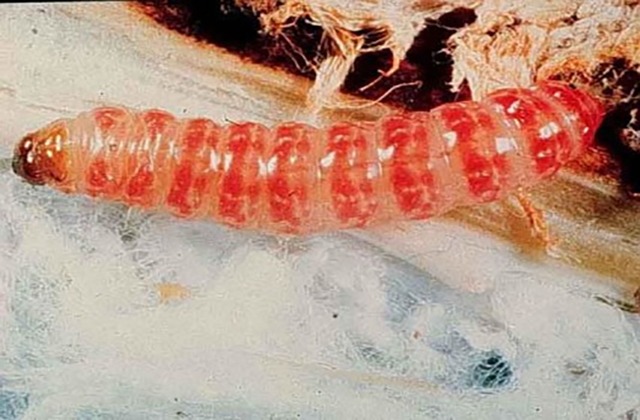
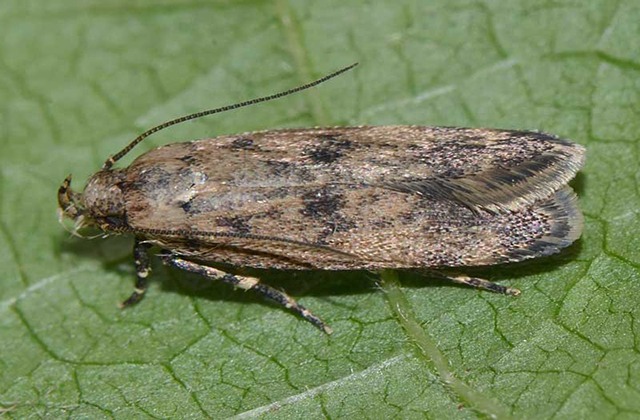
In the subsequent season of 2015-16, heavy infestation of PBW was reported from AP, Telangana and parts of Gujarat but there were very few reports from Maharashtra. Although this was a warning signal in Maharashtra, no care was taken either to restrict the cultivation to short/medium duration hybrids/varieties or to terminate the long duration crop of 2016-17 which was extended till May 2017 because of excellent market prices prevalent then. Farmers were extremely happy as returns on investments were much above their expectation but the fall out then was prolonging the life of cotton, which resulted in the population of PBW, and spill over to subsequent season due to short time between two cotton crops. The unusual outbreak of the pink bollworm pest has hit hard the cotton farmers in Maharashtra in Kharif 2017-18 and subsequently in Kharif 2020-21.
Reasons of Resistance Development in PBW:
Bt cotton technology mismanagement has been responsible for erosion of resistance successfully achieved through development of host resistance by Bt gene incorporation. Let us not expect that Bollgard®II alone in absence of supporting integrated management practices shall last forever. It is well known that by misusing the insecticidal spray of pyrethroid; a classical molecule discovered against the bollworms, beyond recommended protocol created havoc as the American bollworm developed many more than 500 times resistance in the pest against pyrethroids. Bollgard®II has delivered its functions for 20 years could have prolonged its life provided the protocols of technology management were adhered.
The following reasons are but obvious for the loss or erosion of host resistance and ultimately the outbreak of PBW in India:
- In the cotton belt of Central and Southern cotton growing zones, rarely crop rotation is adopted due to small holdings. Continuous planting of cotton year after year is practiced, providing the needed continuity of host for the pest
- Use of unapproved, unauthorised Bt/HT seeds for cultivation in Central and Southern cotton growing zones. It has already been publicised and accepted by the Government of India that nearly 8-10% herbicide tolerant Bt cotton (HT/Bt) cultivars which have not been officially approved for cultivation in India are illegally grown by farmers supplied by fly-by-night operator and unscrupulous seed companies and dealers. Similarly, there are reports that many fly-by-night seed companies just multiply F2 seeds of approved Bollgard®II cotton hybrids (F1). There is no check of such hybrids/varieties for the presence of both the cry genes of Bollgard®II. It is well proved that the bolls of F1 hybrids have segregating seeds in the ratio of 9:3:3:1 according to principle of genetics because the F1 is developed by two genes; Cry1 Ac+ Cry2Ab. F1 bolls carry seeds of both the genes in 9, Cry1Ac in 3, Cry2Ab in 3 and none of the gene in 1. Thus a spectrum of non Bt seeds plus the seeds carrying the two genes singly makes the situation easy for resistance development if F2 seeds are used.
- 3) Cultivation of long duration hybrids that serve as continuous host to PBW. This is further complicated by large number of hybrids of different duration, giving varying flowering and fruiting periods that helps the pest to have continued food in an overlapping manner. In the dry land situating extending the life of cotton plant beyond Jan-Feb by giving protective irrigation is a dangerous practice as the pest cycle is never broken. This practice also tends to dilute the toxin levels beyond 120 days. Therefore, square, flowers and developing seeds in young bolls with less Bt-toxin expression succumb to pest multiplication. Table 1 gives a summary of optimal sowing and picking timing for different zones, which shows how the extended phase of crop intensifies Bt-toxin selection pressure and resistance development is accelerated
Table 1. Sowing and Picking of Cotton in Different Cotton Growing Zones of India
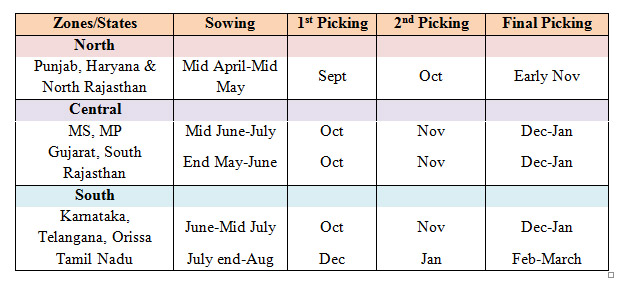
Source: South Asia Biotechnology Centre, 2021
-Rejuvenation of cotton crop beyond Jan-Feb in central zone up to April-May for economic reasons is ecologically unstable for sustainability of cotton over the years. Pink bollworm is mainly a winter pest and the damage in Maharashtra normally commences in late October or November. The damage is maximum in November and December which can be prevented. The pupae enter into diapause phase of life cycle of the pest in December end –January in the absence of crop or its residues like; the cotton stalks. However, if the cotton crop is available beyond this period, the pest does not go to resting stage and continue to survive in fruiting parts resulting in early incidence and higher PBW damage (Figure 2). Therefore, timely termination of Bt cotton crop is a must to break down the life cycle of pink bollworm resulting in a very low carry over of PBW population and lower PBW damage in the following season (Figure 3).

Source: South Asia Biotechnology Centre, 2021
Non-compliance of refugia has been identified as one of the crucial issue in development of resistance to PBW. It has been observed that there is zero to low adoption on non-Bt refuse planting by farmers since the implementation of the technology. In the absence of non-Bt cotton refuge PBW population is constantly exposed to Bt-protein accelerating the build-up of resistance and further resistance development. Table 2 describes the natural availability of refuge crops for bollworms under Indian conditions. PBW is mostly monophagous while other three bollworms are either oligophagous or polyphagous and hence the risk of resistance development in PBW is much higher than other bollworms species. PBW could be under evolutionary pressure to develop resistance and hence artificial refugia plantation is mandatory to avoid resistance build up.
Table 2: Refuge Availability in Indian Fields for Bollworm

Source: South Asia Biotechnology Centre, 2021
Lack of timely and appropriate management initiatives has been a sound reason for development of resistance to PBW in Bollgard-II because of lack of understanding of farmers about Bt-technology. Farmers feel no necessity to initiate control measures against any bollworm on Bt cotton as they think that Bt is panacea to total management. In fact Integrated Pest Management (IPM) practices such as, deep ploughing in summer to expose pupae of PBW to heat, sowing on onset of monsoon, using pheromones traps etc., using proper doses and chemical for early control, not allowing restoring or extension of crop and destruction of cotton crop residues in summer are some of the common IPM practices need to be used also for Bt cotton. Simultaneously, storage of seed cotton in gins without proper sanitation practices can also lead to survival of pest and continuation of life cycle of PBW.
Pink Bollworm Life Cycle:
The pink bollworm Pectinophora gossypiella (Lepidoptera: Gelechiidae), has two different life cycles, unlike many other pests. Each life cycle has four stages including egg, larval, pupal and adult. The pink bollworm lays eggs, which mature into larvae and then pupae before developing into full grown adult moths. It generally takes 4-6 weeks to complete the life cycle. The adult male lives for 20 days whereas the female for 50 days. During early part of the cotton growing season, the larva grow to full size and become pupa or the larva goes into diapause (normally seen in Central and South India). The pink bollworm can adopt to different climatic conditions. During unfavourable times, the larva hide inside the seed and/or debris and can live for many months. It has unique ability to survive and multiply during off season also, when the seed cotton, is stored in gins for a longer time. Apart from the cotton stalks and stubbles, stored by farmers for fuel purpose also help the insect to grow and multiply. Figure 4 illustrates the different forms and life cycle of pink bollworm.

Source: South Asia Biotechnology Centre, 2021
Nature of Symptoms & Damage
Pink bollworm can cause significant yield losses and affect quality of cotton fibre and thus income of cotton farmers
The pink bollworm is a monophagous pest, which can multiply only on cotton and no other host crop. Generally, the pink bollworm is known to infest cotton crop at the later stage sometime from 16–18 weeks after sowing and continues up to 25 weeks after sowing. However, in the Central and South cotton growing areas, especially in irrigated areas, the early sown cotton crop starts flowering in June-July, when the adult moths emerge from soil and start laying eggs. This provides opportunity for the insect to proliferate, leading to early damage to the cotton crop. The larvae cause damage to all reproductive parts of cotton plant particularly square, flowers & bolls. The larvae feed on young floral parts resulting in improper flower development leading to rosette bloom. The young larvae enter the cotton bolls and block the entry holes and remain inside the boll, devouring both seed and fiber forming tissues. The pink bollworm also causes shedding of the immature bolls or staining of the fiber and affect the ginning percentage and spinning quality in case of mature bolls. In nutshell, the pink bollworm not only causes yield loss but also reduces oil content and poor quality of fibre. Similarly, in many cotton growing areas in Central and Southern India, farmers have started extending the cotton cultivation beyond normal time, i.e. usually crop should be terminated by January, therefore providing opportunity for the pink bollworm to reproduce and multiply.
